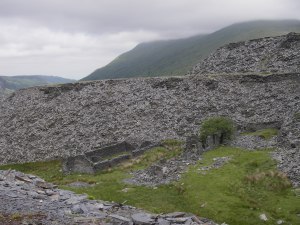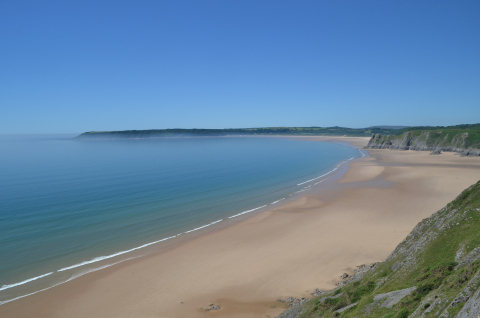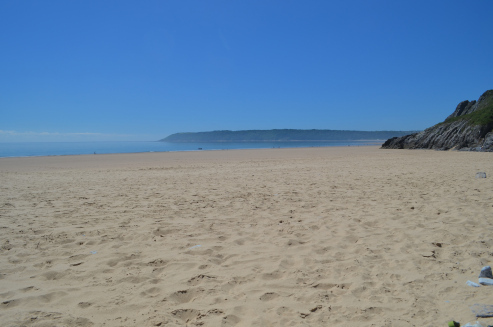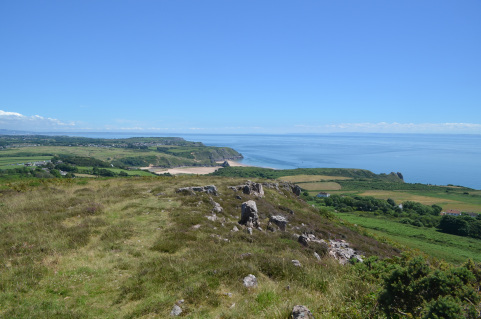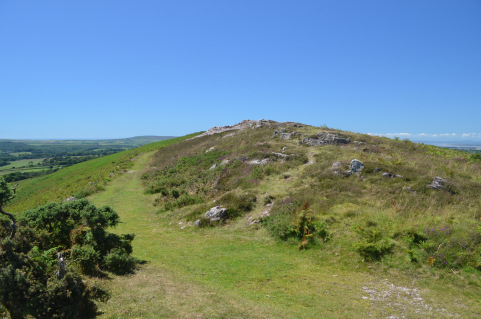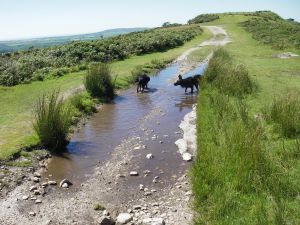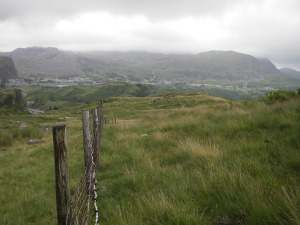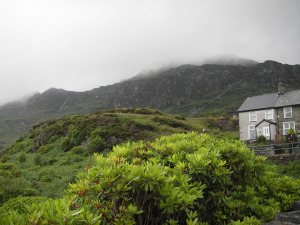R. Harrison's Blog, page 18
July 24, 2016
Mount Snowdon.
The image above shows the view on a good day.
What if it’s not a good day?
Rather one like this:
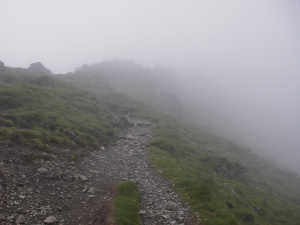
Where the temperature is approaching 4-5C (30 40F), it’s windy and wet.
If you’re prepared, these are excellent conditions for a walk. If you’re not … well, let’s just say “may the force be with you.” You’ll need it.
What do I mean by being prepared? Here’s my gear list.
Rain gear
Winter coat
Thin hiking sweater (Marks and Sparks has an excellent one – wool and silk.)
Wind shirt.
Dry bag in pack containing Fleece, change of clothes. I use a trash-compacter bag as a pack liner.
Food and water.
The rest of the “10 Essentials.” Map, compass, headlamp, first aid kit, and cell-phone.
This looks like an enormous amount to carry. Especially if you add in my camera and GPS. It isn’t. I’ve chosen light-weight gear. The single heaviest think I carried was water (@ 1 kilogram/liter). The total weight was about 3-4 kilograms.
Route Selection
There are five major routes up the mountain. They range from long (following the train) to short and steep (Watkin and Pig trails). We’ve used the Ranger Trail and Rhyd ddu paths. The Ranger Trail is probably the easiest with children. The Pig trail is the shortest climb, but it’s decidedly steep and the parking lot at the base is always a zoo. An informal survey of the people in the restaurant at the top suggested that most either come up the Pig trail or take the train.
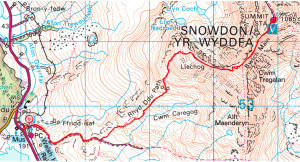 Our route this year was up and down the Rhyd ddu path. My wife and I did this path when we were just married. I think we actually made better time as old-codgers. (Walking poles help, a lot.)
Our route this year was up and down the Rhyd ddu path. My wife and I did this path when we were just married. I think we actually made better time as old-codgers. (Walking poles help, a lot.)
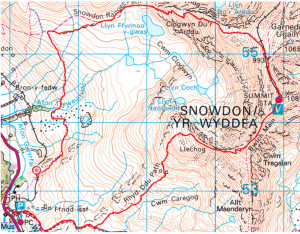 This map shows a trip we made a few years ago. We thought hard about coming back this way, as the Ranger Trail is a lot easier to follow in the dense fog. The path across the bottom, through the abandoned slate quarry, is swampy even in a dry summer. Therefore, rather than face the mire, we decided to take it slowly on the way down.
This map shows a trip we made a few years ago. We thought hard about coming back this way, as the Ranger Trail is a lot easier to follow in the dense fog. The path across the bottom, through the abandoned slate quarry, is swampy even in a dry summer. Therefore, rather than face the mire, we decided to take it slowly on the way down.
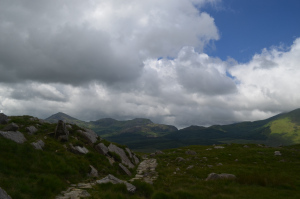
The trail starts with a well-maintained track of large stones embedded in the soft peaty ground. It’s land covered with sheep. We chose shearing day for our stroll; the local farmer had gathered his flock and we started to the noise of distraught ovines.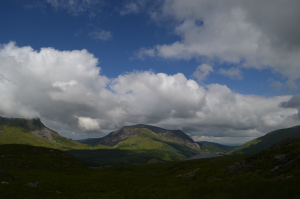 The trail rises faster than you think. I thought we’d been walking on the flat when we stopped here.
The trail rises faster than you think. I thought we’d been walking on the flat when we stopped here.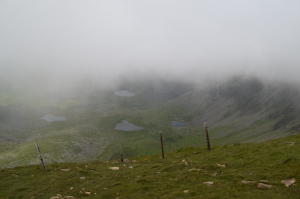 About 1/3-1/2 the way up, the fog descended. It usually burns off by mid-day. I started out looking forward to purchasing a pint at the top. A few minutes later, a cup of tea seemed a much better idea.
About 1/3-1/2 the way up, the fog descended. It usually burns off by mid-day. I started out looking forward to purchasing a pint at the top. A few minutes later, a cup of tea seemed a much better idea. 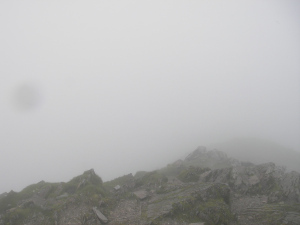 Leaving us with this view from the top.
Leaving us with this view from the top.


July 23, 2016
The Art of Deception 24
or Pride and Extreme Prejudice

Welcome to Weekend Writing Warriors. This week continues a spy story set in late Georgian England, the year before Trafalgar. Last week, Alice was surprised by Roderick, in church, just after she congratulated herself about ‘doing her bit’ for Britain. This week, after service, she escorts ‘her charge’ Lucy to visit Mr Spode and deliver the details of a proposed trip to Bath. Alice has just been asking questions of the innkeeper where Mr Spode and Mr Stanton are staying. Roderick finds her in the process.
Alice spun round and coloured, which did not stop her from replying, “You were asking your share of pointed questions about me on our walk here, Mr Stanton; I thought it only fair that I asked my share about you.”
“Roddy, old boy!” Edward joined them and interrupted what could have been an interesting exchange, “I see you’ve found the lovely Miss Mapleton; Lu- Miss Haytor says you have a message for me.” Lucy was not far behind him.
Glad of the respite, Alice pulled a letter from her reticule and handed it to him, “Sorry … here it is Mr Spode; this gives our plans for travel to Bath, and Miss Haytor’s address there; I, of course, shall be staying with her, as well as her Aunt, Miss Heather.” She curtsied and then turned to Lucy, “Miss Haytor, our carriage should be here soon; I shall see if it’s here … Lucinda, please come.”
Once the two women left, Edward asked his friend, “So My Lord did you find anything out about the young Miss Mapleton?”
“Only that she’s got her wits about her; gave me a long line of faradiddles and Canterbury tales; she didn’t trip up once; I must say the French are recruiting a better class of agent than they did in the past.”
Now that you’ve read my hackery, please see the talented writers in Weekend Writing Warriors.
My apologies for creative punctuation.
The Gillray cartoon I’ve added as a featured image is suggesting that maybe, in 1793, the British should not follow the French into revolution. It’s sort of relevant in these days of Brexit (though I would have voted remain – had I a vote). None the less, it is reasonably humorous. By the way, the “Thomas Pain” staymaker, refers to the “Thomas Paine” author of “the American Crisis” – from the American Revolution.
In searching for the cartoon, I found a number of modern cartoons that directly quote Gillray. Here’s an example that I think is safe to use.
Like poor Cecelia, “The Curious Profession of Dr Craven” is back from the dead.
I’ve released a sweet regency romance, Miss DeVere 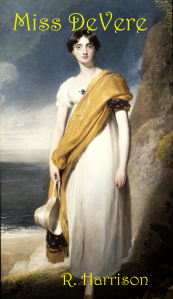 This is a fun read.
This is a fun read.
Frankenkitty is available.
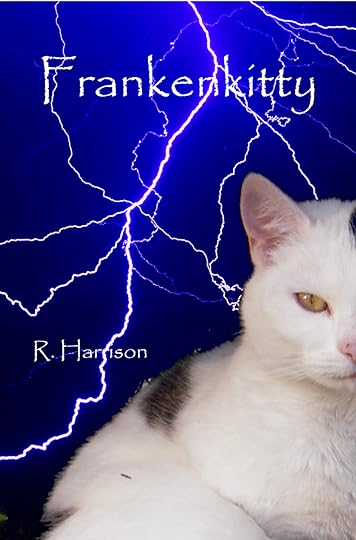 What happens when teenagers get to play with Dr Frankenstien’s lab notebooks, a few odd chemicals and a great big whopping coil? Mayhem, and possibly an invitation to the Transylvanian Neuroscience Summer School.
What happens when teenagers get to play with Dr Frankenstien’s lab notebooks, a few odd chemicals and a great big whopping coil? Mayhem, and possibly an invitation to the Transylvanian Neuroscience Summer School.


July 21, 2016
A Fun Walk on the Gower (or Gwr).
A 13.5 mile, 22 km walk through one of the most beautiful beaches/wild spots in the UK. It combines beaches with hills and heather in a unique walk. This is a fairly strenuous walk, at least when the temperatures reach 28 (90ish). There’s a decent amount of climbing, but no truly long epic climbs (the total climb, about 2400 feet or 740 metres, is most of the way up Snowdon).
The Gower is about a 2 hour drive from Bristol and an hour from Cardiff. We started about 9 in the morning to miss the rush-hour traffic, stopped at a bakery on the way, and ate our lunch (Pasty’s and bread-pudding) at the National trust car park (3.50 for all day, Oxwich bay is 2.00). The picture above shows the view from near the top. The tide was out so we climbed down and around the Great Tor. The day was exceedingly clear, so sunscreen would have been a good idea. Hindsight is 20/20. The UV in the UK can be surprisingly strong, even stronger than in the American South.
After that we climbed up onto the Gower path which follows the spine of the peninsula. There’s some free parking where the path crosses the main road.
This shows our progress. We’re parked at the top of the cliffs in the centre left. The dim blue line at the horizon is Devon.
We ran into the first of three Duke of Edinborough crews on this hill. They (the program) seriously need to look at lighter weight pack gear. One of the girl’s packs was forty pounds or so for a short trip. Hers was on the light side. I gave them some Philmont advice (It’s not a race and “Hydrate or die!”) for hiking in the heat. My brother-in-law’s dogs found their own way to deal with the heat.
Then we climbed down to Oxwich. We refilled our water bottles at a tap in the campsite – which they may not approve of, but what they don’t know won’t hurt them. (It’s a lovely site, but does not take pets). We also stopped at the store for a choc-ice, which was well-received.
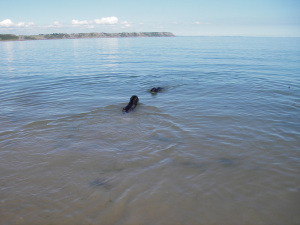 The tide was now in, which the dogs enjoyed. It also meant we had a digression on the way back. Unless we wanted to swim. (We considered it.)
The tide was now in, which the dogs enjoyed. It also meant we had a digression on the way back. Unless we wanted to swim. (We considered it.)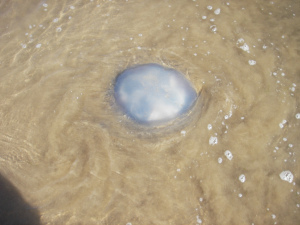
This is an example of a large blue jellyfish that was washed up on shore. There were at least three other species in the water. Most of them don’t sting.
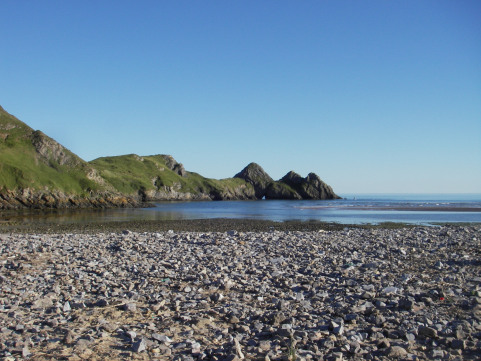 Three cliffs bay with the tide in.
Three cliffs bay with the tide in.
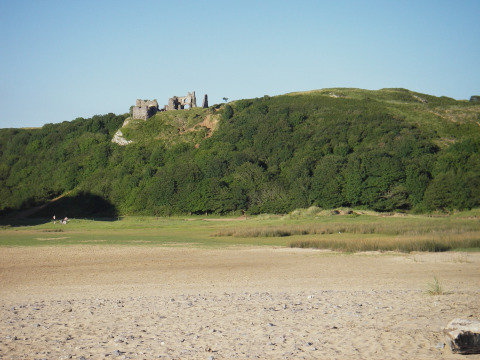 Pennard Castle. It’s in the middle of a golf course, so visit with caution (and keep an ear out for ‘fore’).
Pennard Castle. It’s in the middle of a golf course, so visit with caution (and keep an ear out for ‘fore’).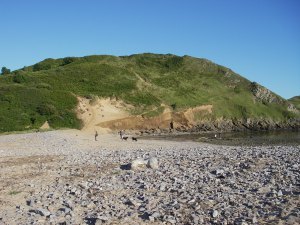
This last picture shows one of the sandy climbs. Climbing a sandy bluff is much harder work than climbing a stoney path.


July 19, 2016
A Yank’s Guide to the UK part 3, Footpaths.
You may have noticed that I like to walk. Maybe it’s all those trailmaps I’ve posted. (A big thank you to this site for their help with tracks.)
Anyway one of the joys of the UK is the public footpaths or rights of way. They’re designated with red dashed lines on the 1:50000 landranger series and green dashed, dotted and other lines on the 1:25000 explorer series from the ordnance survey. The symbols are a little different from the USGS maps, but close enough that if you can read one, you can read the other. Like the US maps they have a blue background grid that is a kilometer grid based on a zero point. (Canada does something similar, and shares the datum with the USA, but they sometimes use an older one that’s about 300 meters off. Be warned.) The British use their own national grid that is similar to the US one, but based on their own origin. You’ll see numbers like SN339486 which refers to a specific location. You can interpolate the numbers from the map, enter them into your gps and find a specific neolithic stone circle on a heath in Exmoor. (it was literally a circle of small stones.)
In England, the footpaths generally go where the map says they are. There are exceptions, but if you navigate stile to stile, you’ll be OK. 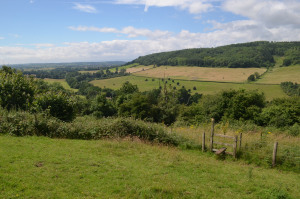 The picture shows a style on a typically beautiful summer day. Or perhaps one good enough to be typical. Many of the styles are gates, and the rule is to leave the gate the way you found it.
The picture shows a style on a typically beautiful summer day. Or perhaps one good enough to be typical. Many of the styles are gates, and the rule is to leave the gate the way you found it.
Many of the footpaths follow historic tracks or roads. Often these are sunken lanes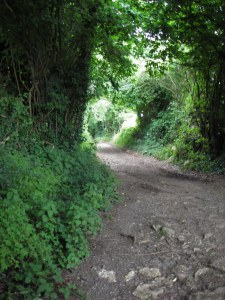 where the effort of expanding them for even a single track ‘metalled’ (paved) road would exceed the effort needed to just build a new road nearby. These paths can be ancient. The ridgeway that runs from near Reading to south of Bath dates to the time of the pyramids. It’s sort of exciting to walk on a road that was old and in use when Julius Caesar was a boy.
where the effort of expanding them for even a single track ‘metalled’ (paved) road would exceed the effort needed to just build a new road nearby. These paths can be ancient. The ridgeway that runs from near Reading to south of Bath dates to the time of the pyramids. It’s sort of exciting to walk on a road that was old and in use when Julius Caesar was a boy.
The public footpaths can go through people’s back gardens – including quite famous people’s back gardens. (There’s a rock star near Dorchester (near Oxford), whose back garden is crossed by one.)
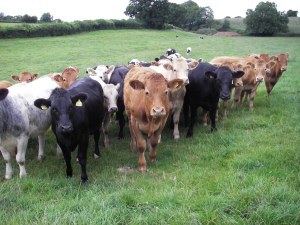 The footpaths often cross fields with livestock. Cows are a real hazard. They are not the calm sweet animals from cartoons and milk advertisements. Big and sometimes ornery, especially the beef cattle which are not handled by people on a routine basis, they need to be treated with respect. Every now and then someone who doesn’t treat them with respect gets trampled. Sheep are extremely common, but other than decorating the trail in their own unique manner, not much of a bother. There are also a fair number of horses, especially in wilder areas.
The footpaths often cross fields with livestock. Cows are a real hazard. They are not the calm sweet animals from cartoons and milk advertisements. Big and sometimes ornery, especially the beef cattle which are not handled by people on a routine basis, they need to be treated with respect. Every now and then someone who doesn’t treat them with respect gets trampled. Sheep are extremely common, but other than decorating the trail in their own unique manner, not much of a bother. There are also a fair number of horses, especially in wilder areas.
Wales, however, is another story. 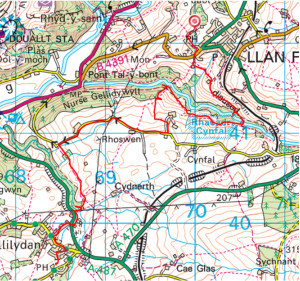 While there are plenty of footpaths and they are marked on the maps, they are often not there in reality. This map from 2013 shows our path … digressing from the footpath. What started as a gentle walk to a pub in a nearby town, became an almost epic journey as we worked our way around closed footpaths. We took the bus home.
While there are plenty of footpaths and they are marked on the maps, they are often not there in reality. This map from 2013 shows our path … digressing from the footpath. What started as a gentle walk to a pub in a nearby town, became an almost epic journey as we worked our way around closed footpaths. We took the bus home.
Trail conditions range from smooth and dry, to bogs, and on to mud pits. The paths can be wide and easy walking or narrow and filled with nettles. Fortunately, outside of Kew Gardens, there’s no poison ivy.
Water sources are few, and you will need to be prepared. I’ll put it up in another post, but my wife and I did Snowdon last week. We were prepared, and needed to be. It wasn’t a bad climb, but the temperature changed from a balmy 20C at the base to about 5C at the top, in dense fog, dripping wet. Hypothermia was a real risk. Especially as you’d be damp from sweating on the climb. So we carried rain gear, winter coats, dry change of clothes, my backcountry first aid kit (which contains a space blanket for a bivy), water, and extra food. We needed the warm clothes by the time we arrived at the top. The point of this is that you have to do your research and be prepared for what you may encounter.


July 15, 2016
The Art of Deception 23
or Pride and Extreme Prejudice

Welcome to Weekend Writing Warriors. This week continues a spy story set in late Georgian England, the year before Trafalgar. Last week Lucy and Alice are being debriefed, to use a modern phrase, in their carriage on the way back to their rooms. Her instructors decided that Roderick, while not certainly a French spy, was dashed suspicious. Alice, accompanying her mistress, Lucy, and Lucy’s “Aunt Heather” is at church prior to delivering the bait to Roderick and his companion.
Alice smiled to herself at the prayer to save the nation from the French; she was doing her bit by laying a trap for a perfidious French agent; after service, she planned to take a stroll to the Swan and deliver the bait. Seated next to her charge, Miss Haytor and sandwiched by Miss Haytor’s ‘Aunt’, Miss Aldershot – now called Miss Heather, she let her attention wander.
It snapped back; there, seated almost within reach, in the next row, was that spy; how could she have missed him? He turned, tilted his head, and smiled at her; was he following her; This wasn’t the local church for the Swan? He had not been there when they first sat in their pew; she nudged Miss Aldershot; once she had her attention, she discreetly pointed to the man and whispered, “That’s him.”
The only response this brought was a brief raising of her eyebrows, and a whisper in return, “You’ll have to introduce us after the service.”
As the final stanza’s of the last hymn finished and everyone closed their book of common prayer, the man turned to her and said, “Miss Green?”
“Miss Mapleton.” She curtsied, at least as much as she could in the confines of the pew. “Miss Green is my rich cousin, or don’t you remember?”
Now that you’ve read my hackery, please see the talented writers in Weekend Writing Warriors.
My apologies for creative punctuation.
During Sunday prayers, at every church in Bristol, if not in Britain, the priest added a prayer for the nation. “Preserve us from the invading French hordes.” Across the channel, in Boulogne, l’Armee d’Angleterre waited, rumoured to be a million men, all veteran French soldiers, all thirsty for English blood – and English maidens. An exhortation to join the militia, and a reminder that drill practice was after the service usually followed the prayer. Nearly every able young man had joined, hoping, and secretly praying, enthusiasm would make up for a lack of equipment and experience.
Like poor Cecelia, “The Curious Profession of Dr Craven” is back from the dead.
I’ve released a sweet regency romance, Miss DeVere  This is a fun read.
This is a fun read.
Frankenkitty is available.
 What happens when teenagers get to play with Dr Frankenstien’s lab notebooks, a few odd chemicals and a great big whopping coil? Mayhem, and possibly an invitation to the Transylvanian Neuroscience Summer School.
What happens when teenagers get to play with Dr Frankenstien’s lab notebooks, a few odd chemicals and a great big whopping coil? Mayhem, and possibly an invitation to the Transylvanian Neuroscience Summer School.


Things I collect. #lifebookswriting
So many things, dust, bugs, rejection letters, but really miles (All right EU, kilometres), miles and peaks.
I started walking as a boy, serious walking that is. I’ve always had a great sense of direction (Funny thing that, the sun setting in the East, let’s keep moving) and a willingness to explore. There aren’t many blank parts of the map, but you can always leave it in its case.
In order to pull this off you need to have endurance rather than stamina. I’ll stop for breath on a hill, and I’m by no means the fastest walker out there. The thing is, tomorrow I can get up and do the same thing over again. When I think about it these are probably good traits for a writer.
With the advent of GPS I’ve even kept tracks.
Here are a few fun ones:
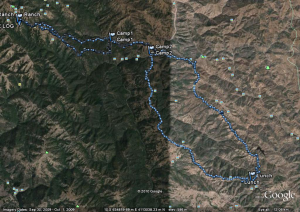 This shows a trip I took a few years ago in Henry Coe State Park, in California. I had a business trip and rather than stay in a hotel for a few days to make up my week (and cheaper airfare) I took my backpacking gear along. One of the advantages of lightweight backpacking is you can fit it in a suitcase. I was testing out solo backpacking with an eye to the AT. I was “the backpacker” in the park that weekend. Did I mention it’s only 15 miles or so from San Jose?
This shows a trip I took a few years ago in Henry Coe State Park, in California. I had a business trip and rather than stay in a hotel for a few days to make up my week (and cheaper airfare) I took my backpacking gear along. One of the advantages of lightweight backpacking is you can fit it in a suitcase. I was testing out solo backpacking with an eye to the AT. I was “the backpacker” in the park that weekend. Did I mention it’s only 15 miles or so from San Jose?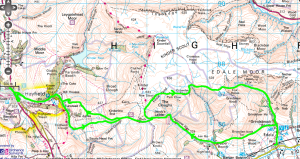 This is a walk in the Peak District from Hayfield to Edale and back. We missed a train so it went a little longer than usual.
This is a walk in the Peak District from Hayfield to Edale and back. We missed a train so it went a little longer than usual.
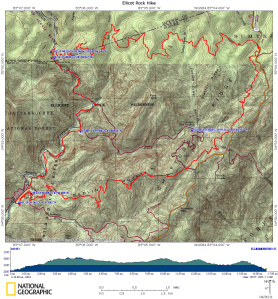 This is one near home I organized for the scouts. It was designed for a two-night over 18 miles trip for the backpacking merit badge. It was the first time I tried trail-runners (fancy trainers with vibram soles). I haven’t looked back.
This is one near home I organized for the scouts. It was designed for a two-night over 18 miles trip for the backpacking merit badge. It was the first time I tried trail-runners (fancy trainers with vibram soles). I haven’t looked back.
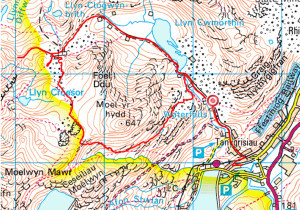 This one is from this year’s visit to the UK. It’s a warmup for Mt Snowdon. It’s also neat because you visit about 6 disused quarries. There are a many mine-pits on the south side of Moel-yr-hydd, so you have to be careful. It’s so beautiful that I think I’ll try learning Welsh so I can visit after Brexit.
This one is from this year’s visit to the UK. It’s a warmup for Mt Snowdon. It’s also neat because you visit about 6 disused quarries. There are a many mine-pits on the south side of Moel-yr-hydd, so you have to be careful. It’s so beautiful that I think I’ll try learning Welsh so I can visit after Brexit.


Another Installment.
July 12, 2016
Moel yr-hydd Loop
This is a fine, relatively unused, 7 mile 2000 foot climb walk. The rain finally held off so we grabbed the chance.
The trail map shows the house we’ve hired, but you can park for free near the top of the paved road.
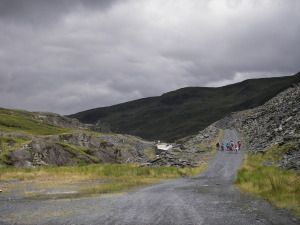 We walked in the original quarry road, along a stream and waterfalls. The people in this picture were getting ready to explore one of the many mines on the mountain. Off picture, to the left, is a steep hill of tailings and various miner paths that leads up to an abandoned quarry. We came back that way.
We walked in the original quarry road, along a stream and waterfalls. The people in this picture were getting ready to explore one of the many mines on the mountain. Off picture, to the left, is a steep hill of tailings and various miner paths that leads up to an abandoned quarry. We came back that way.
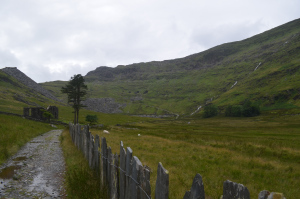 Once inside you skirt a lake and then follow an old road to an abandoned village. There’s a bitter-sweet poem, in Welsh, attached to the start of this slate fence. It says they have a new school, an new pub, an new hotel, and it’s all gone.
Once inside you skirt a lake and then follow an old road to an abandoned village. There’s a bitter-sweet poem, in Welsh, attached to the start of this slate fence. It says they have a new school, an new pub, an new hotel, and it’s all gone.
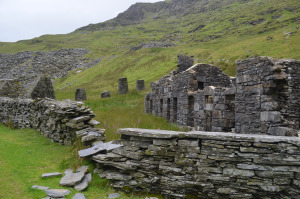 We ate lunch in the middle of the ruins. Our choice dictated by the availability of dry seats.
We ate lunch in the middle of the ruins. Our choice dictated by the availability of dry seats.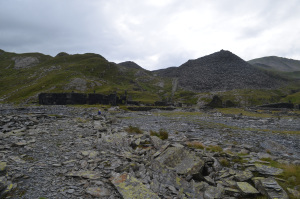
Following the path uphill, did I mention there’s a lot of that in this hike, you reach another abandoned quarry. It’s only the second of six. The vertical bar in the background, next to a mine opening, is the reliable and dry footpath. How did we find that out? By trying the others.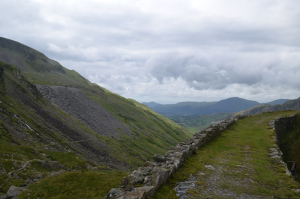 When we got here we realized that we didn’t want to walk down Cwm Creosoe.
When we got here we realized that we didn’t want to walk down Cwm Creosoe.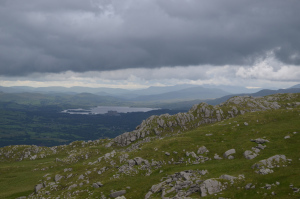
Following the old gravity slides (only 20% grade or so), leads to a saddle with views like this.
We followed the footpath down. Until it disappeared into a swamp. So we ended up following informal paths (Sheep trails) to a final abandoned quarry. Then after a steep decline, we found the path we came up.
All in all an enjoyable exploration. Just be prepared for bogs, lots of bogs.


July 11, 2016
A Yank’s Guide to England 2 – Pubs and Food.
It’s 15C, windy and raining, horizontally. Not a great day for exploring mountains. Sounds like a pub is in order.
Pubs are the great British social institution. Dogs and children are welcome, though you do have to smoke in the garden. (I find this a great improvement, but others feel it is an overbearing aspect of the nanny state.) The best are local, almost community centres, that feel like one big family room. The worst are commercial and somewhat impersonal. None are as awful as an American bar. They’re more than just a dispensary for alcoholic beverages. No self-respecting village is without at least one pub.
Originally they were inns and stopping points for the masses. Back before trains when nearly everyone walked, it took more than a few hours to go from one end of the island to the other. Once King Henry destroyed the Abbeys and Monasteries that housed travellers, public houses evolved to fill that role. While some still do, most pubs now don’t have overnight rooms. You’ll also read about licensing rules and pubs closing at strange hours. These were introduced to help win ‘the war to end all wars.’ The first one of those wars, a hundred years ago. One of the best things labour ever did was to revoke the rules. Now pubs are open when there’s a market for their services. (which means in the country, don’t count on them being open out of hours). By the way, the drinking age is 18.
Pubs come in basically three flavours: free house, brewer associated, and chain. Chain pubs are franchises like McDonalds, reasonable places, but nothing super special. Brewer associated will have a brewer’s name over the door. They get a deal from or may be owned by a brewery. In Berkshire around Reading a fair number of pubs used to have ‘Courage’ over the door which was a nice touch. Free houses are owned outright by the publicans and serve whatever beers they want. Free houses are usually the best, the most idiosyncratic, and typically British you will find. I aim for them, and so should you.
Ordering: Typically you walk up to the bar and wait your turn. There will always be some ‘locals’ i.e. people who haunt the pub as their almost primary residence. You may have to wait a bit to be noticed. Be polite. They will pointedly ignore a ‘loud Yank.’ Beer comes in pints and half pints. Ask for what’s the best bitter and you won’t be disappointed. American beer is lager. A typical ‘lady’s drink’ is lager and lime. You cannot get that in the USA, so even if you’re a bloke, give it a try. Cider is alcoholic. You can get a variety of soft-drinks for the children. The fruit squashes are very sweet. You also would order food here. It’s good manners to know what you’re ordering before you go to the bar. After all other people are waiting for their drinks.
Pub Food: The French believe the British can’t cook. They also believe chicken is suitable for vegetarians. At least they’ve got something right. The thing about the British and the English in particular is they won’t complain. Some restaurants take advantage of this to serve awful food. The good ones won’t. The British also became accustomed to pretty bloody awful food during an unfortunate event in the middle of the 20th century. And they never were fond of snails – or frogs.
Good pub food can hold its head up with respect to any cuisine in the world. Things to try are: fish and chips, Sausage and chips, and meat pies with or without chips. I’d skip a ploughman’s. They tend to be overpriced. You may be offered ‘mushy peas.’ They are an acquired taste, but you should try them at least once. Never mind that they look like something the cat regurgitated. You may get a chance to have ‘black pudding.’ Take it.
Non Pub-food:
Pizza has made it to the UK. It’s served as pizzas. Each typically the size of a plate and for one person.
Digestive biscuits are a delight. The base biscuit is similar to graham cracker, and you can (should) get them covered in chocolate. Ginger nuts are another biscuit worth tasting. American children often subsist on digestives when visiting the UK, since everything tastes a little different.
Bacon is different. It has meat in it. Lots of meat. Enjoy it while you can.
Sausage. My in-laws wonder why my wife and I binge on this when we’re here. Especially why we have the inexpensive plain sausages. It’s a unique and addictive flavour. One you can’t get back in the good ol’ USA.
Baked Beans. I only mention this because some people are in for a surprise. I wouldn’t bother with them in the UK. No where near as good as in the USA.
Fruits and Veggies. There’s a huge variety here now. This may change with Brexit. With apples especially, look for varieties that aren’t found in North America. Strawberries are also much nicer than you can get at home.
Cheese. The UK has its own varieties and they are excellent. Try Leicester, Cheshire, Wensleydale, Stilton, and mature (local) Cheddar. The orange brick cheese in the US will pale in comparison.


July 10, 2016
Blaenau Ffestiniog
This isn’t a long hike, sort of a rest day. We needed a small number of supplies from the local Co-op, it is rainy, windy and cold. A welcome change from Atlanta where it is dry, hot (95F, 34C), and smelling of car exhaust.
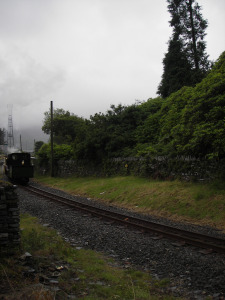 There is a steam train, so we do get the occasional wiff of coal smoke. That’s a welcome change.
There is a steam train, so we do get the occasional wiff of coal smoke. That’s a welcome change.
The local websites give the times for the Snowdon train, but we’ll do that trip under our own power. There’s a 35L ticket that lets you use this train and the busses all day.
We hiked first uphill and across the face of old slate workings. Originally I planned to go for a longer bit of the trail, but the soil is completely waterlogged. It is a normal Welsh summer.
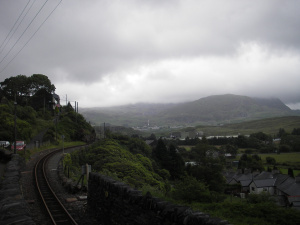 The tracks, sans train, run uphill from the house we hired.
The tracks, sans train, run uphill from the house we hired.
Blaenau Ffestiniog from the hill. Our feet were still dry at this moment.
The clouds cover the mountains in this weather. Serious wet-weather gear is a necessity in these mountains. This is a place where you can get in trouble quickly, and not for speaking English in the Y Tap (a Welsh language pub that’s only a kilometer away).
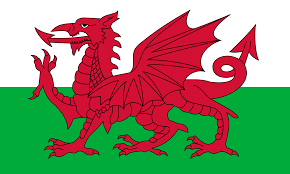 Welsh flags are everywhere. They did well in the EU cup, not so well in the Brexit vote.
Welsh flags are everywhere. They did well in the EU cup, not so well in the Brexit vote.



